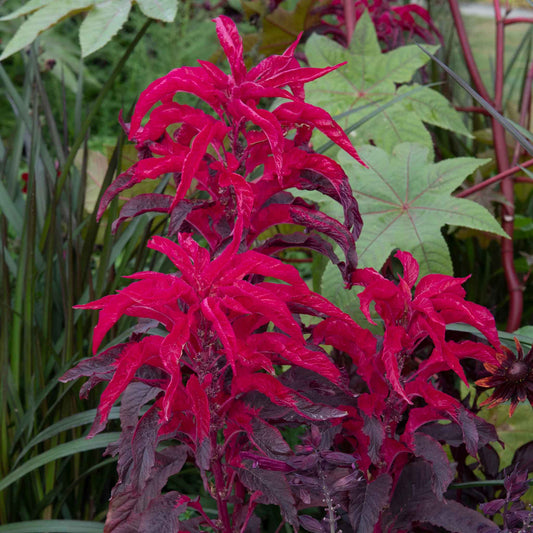-
main-collection-product-grid

Amaranthus Seeds - Pygmy Torch
This compact heirloom variety is perfect for drying and craftingAmaranthus Seeds - Pygmy Torch
This compact heirloom variety is perfect for drying and craftingRegular price As Low As $4.99Regular priceUnit price per -
main-collection-product-grid

Love Lies Bleeding Seeds
A unique growth habit of cascading pink plumes to attract pollinatorsLove Lies Bleeding Seeds
A unique growth habit of cascading pink plumes to attract pollinatorsRegular price As Low As $4.99Regular priceUnit price per -
main-collection-product-grid

Amaranthus Seeds - Green Thumb
Experienced and beginning gardeners alike will appreciate this edible ornamentalAmaranthus Seeds - Green Thumb
Experienced and beginning gardeners alike will appreciate this edible ornamentalRegular price As Low As $4.99Regular priceUnit price per -
main-collection-product-grid

Amaranthus Seeds - Viridis
The distinctive green tassels are perfect for dramatic bouquetsAmaranthus Seeds - Viridis
The distinctive green tassels are perfect for dramatic bouquetsRegular price As Low As $4.99Regular priceUnit price per -
main-collection-product-grid

Amaranth Seeds - Red Garnet
Antioxidant filled fuchsia leaves makes wonderfully rich microgreensAmaranth Seeds - Red Garnet
Antioxidant filled fuchsia leaves makes wonderfully rich microgreensRegular price As Low As $4.99Regular priceUnit price per -
main-collection-product-grid

Amaranth Seeds - Green Callaloo
High heat tolerance, young leaves can be eaten raw or in soupsAmaranth Seeds - Green Callaloo
High heat tolerance, young leaves can be eaten raw or in soupsRegular price As Low As $4.99Regular priceUnit price per -
main-collection-product-grid

Amaranthus Seeds - Perfecta
Festive firecracker-like foliage adds interest in the gardenAmaranthus Seeds - Perfecta
Festive firecracker-like foliage adds interest in the gardenRegular price As Low As $5.99Regular priceUnit price per -
main-collection-product-grid

Amaranthus Seeds - Hot Biscuits
Holds their beautiful rustic color longer than most amaranthsAmaranthus Seeds - Hot Biscuits
Holds their beautiful rustic color longer than most amaranthsRegular price As Low As $5.99Regular priceUnit price per -
main-collection-product-grid

Amaranthus Seeds - Molten Fire
Ruby-colored new growth contrasts with mature foliage for a striking visual effectAmaranthus Seeds - Molten Fire
Ruby-colored new growth contrasts with mature foliage for a striking visual effectRegular price As Low As $4.99Regular priceUnit price per -
main-collection-product-grid

Amaranthus Seeds - Joseph's Coat Early Splendor
Green leaves change to stunning bright shades of orange, yellow, and red throughout the summerAmaranthus Seeds - Joseph's Coat Early Splendor
Green leaves change to stunning bright shades of orange, yellow, and red throughout the summerRegular price $5.99Regular priceUnit price per -
main-collection-product-grid

Amaranthus Seeds - Autumn's Touch
Plumes display an unusual color pattern from green to bronzeAmaranthus Seeds - Autumn's Touch
Plumes display an unusual color pattern from green to bronzeRegular price $4.99Regular priceUnit price per -
main-collection-product-grid

Amaranthus Seeds - Coral Fountain
Velvety, coral-pink tassel-like flower heads on long stemsAmaranthus Seeds - Coral Fountain
Velvety, coral-pink tassel-like flower heads on long stemsRegular price $5.99Regular priceUnit price per
About our amaranth seeds
- Multiple varieties of amaranth to choose from
- Both ornamental and edible
- Can be used in cut flower arrangements
- Drought-tolerant
what makes amaranth so popular?
Many gardeners have popularized amaranth as an ornamental flower. However, it is also an edible plant that is grown in many parts of the world for its grain-like seeds. The use of amaranth as a decorative plant is relatively new, as historically it has been grown as source of food in countries all over the world. In fact, it is considered an ancient grain! Edible amaranth is frequently grown for the bountiful seeds that hang like chandeliers from the plant. Amaranth varies in flower, leaf, and stem color from crimson to maroon, making a real point of interest in the yard. There are many varieties, some that grow up to a towering ten feet tall! It's great stalks make for a wonderful trellis for vine plants such as beans and peas to climb up. Not only that, but it's grain provides delicious treats for birds. Bees are also attracted to the flowers produced by amaranth.
when and how to plant amaranth seeds
Start your amaranth seeds in the spring. While you can direct sow the seeds, we recommend starting them indoors about six to eight weeks before the last frost is expected. Select a site that receives full sun and has well-draining soil (not dense clay). Plant the seeds about 10 to 12 inches apart and then cover them lightly with soil. The seeds will germinate within three to four days, so long as the temperatures are between 60 and 90°F. When ready to transplant outdoors (if you started indoors), sow them about one to two feet apart. Because it is drought resistant, it is only necessary to water once or twice a week during dry periods. For tall plants, add some fertilizer once or twice a year, or add compost. The average amaranth grows between four and six feet tall, but with rich soil and plenty of nitrogen and phosphorous, the plants can reach heights as tall as eight feet.
harvesting amaranth
Amaranth will continue to flower until the first hard frost, meaning there will be plenty of seed to harvest in the meantime! After about three months, seeds from the flowers will be ready to harvest. Simply shake the flower heads and catch the falling leaves with a large bowl or bag. If you aren't looking to harvest the seeds, you can also, cut and dry amaranth and include them in dry flower arrangements.
For more information about planting, growing, and caring for amaranth seed, see the Amaranth Seeds Planting Guide.











